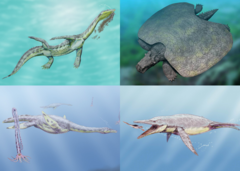Sauropterygia
| Sauropterygians Temporal range: Early Triassic - Late Cretaceous,
| |
|---|---|

| |
| Sauropterygia diversity. Clockwise from top left: Ceresiosaurus calcagnii (Nothosauroidea), Henodus chelyops (Placodontia), Brachauchenius lucasi, Aristonectes parvidens (Plesiosauria). | |
| Scientific classification | |
| Domain: | Eukaryota |
| Kingdom: | Animalia |
| Phylum: | Chordata |
| Class: | Reptilia |
| Clade: | Neodiapsida |
| Superorder: | †Sauropterygia Owen, 1860 |
| Subgroups | |
| |
Sauropterygia ("lizard flippers") is an extinct taxon of diverse, aquatic reptiles that developed from terrestrial ancestors soon after the end-Permian extinction and flourished during the Triassic before all except for the Plesiosauria became extinct at the end of that period. The plesiosaurs would continue to diversify until the end of the Mesozoic. Sauropterygians are united by a radical adaptation of their pectoral girdle, adapted to support powerful flipper strokes. Some later sauropterygians, such as the pliosaurs, developed a similar mechanism in their pelvis.
Origins and evolution[edit]

The earliest sauropterygians appeared about 247 million years ago (Ma), at the start of the Middle Triassic: the first definite sauropterygian with exact stratigraphic datum lies within the Spathian division of the Olenekian era in South China.[1] Early examples were small (around 60 cm), semi-aquatic lizard-like animals with long limbs (pachypleurosaurs), but they quickly grew to be several metres long and spread into shallow waters (nothosaurs). The Triassic-Jurassic extinction event wiped them all out except for the plesiosaurs. During the Early Jurassic, these diversified quickly into both long-necked small-headed plesiosaurs proper, and short-necked large-headed pliosaurs. Originally, it was thought that plesiosaurs and pliosaurs were two distinct superfamilies that followed separate evolutionary paths. It now seems that these were simply morphotypes in that both types evolved a number of times, with some pliosaurs evolving from plesiosaur ancestors, and vice versa.
Classification[edit]
Classification of sauropterygians has been difficult. The demands of an aquatic environment caused the same features to evolve multiple times among reptiles, an example of convergent evolution. Sauropterygians are diapsids, and since the late 1990s, scientists have suggested that they may be closely related to turtles. The bulky-bodied, mollusc-eating placodonts may also be sauropterygians, or intermediate between the classic eosauropterygians and turtles. Several analyses of sauropterygian relationships since the beginning of the 2010s have suggested that they are more closely related to archosaurs (birds and crocodilians) than to lepidosaurs (lizards and snakes).[2] Some authors have suggested that Sauropterygians form a clade with two other groups of marine reptiles, Ichthyosauromorpha and Thalattosauria, with this clade either being placed as non-saurian diapsids or as basal archosauromorphs.[3][4]
The cladogram shown hereafter is the result of an analysis of sauropterygian relationships (using just fossil evidence) conducted by Neenan and colleagues, in 2013.[3]
| |||||||||||||||||||||||||||||||||||||||||||||||||
The cladogram shown below follows the most likely result found by an analysis of turtle relationships using both fossil and genetic evidence by M.S. Lee, in 2013. This analysis resolved Sauropterygia as a paraphyletic assemblage of stem turtles.[2]
| Crown Reptilia/ | |
| Sauria |
In cladistic analysis of 2015, Sauropterygia placed within Pantestudines:[5]
| Sauria | |
| (=Archelosauria) |
The following cladogram was found by Simões et al. (2022):[4]
| Neoreptilia |
| ||||||||||||||||||||||||||||||||||||||||||||||||||||||||||||
Ecology[edit]
Placodonts are thought to have been durophagous, using rounded teeth to crush hard shelled organisms.[6] Members of Eosauropterygia are thought to have been piscivores and carnivores.[7]
References[edit]
- ^ Ji Cheng, et al. 2013. "Highly diversified Chaohu fauna (Olenekian, Early Triassic) and sequence of Triassic marine reptile faunas from South China", in Reitner, Joachim et al., eds. Palaeobiology and Geobiology of Fossil Lagerstätten through Earth History p. 80
- ^ a b Lee, M. S. Y. (2013). "Turtle origins: Insights from phylogenetic retrofitting and molecular scaffolds". Journal of Evolutionary Biology. 26 (12): 2729–2738. doi:10.1111/jeb.12268. PMID 24256520. S2CID 2106400.
- ^ a b Neenan, J. M.; Klein, N.; Scheyer, T. M. (2013). "European origin of placodont marine reptiles and the evolution of crushing dentition in Placodontia". Nature Communications. 4: 1621. Bibcode:2013NatCo...4.1621N. doi:10.1038/ncomms2633. PMID 23535642.
- ^ a b Simões, T. R.; Kammerer, C. F.; Caldwell, M. W.; Pierce, S. E. (2022). "Successive climate crises in the deep past drove the early evolution and radiation of reptiles". Science Advances. 8 (33): eabq1898. Bibcode:2022SciA....8.1898S. doi:10.1126/sciadv.abq1898. PMC 9390993. PMID 35984885.
- ^ Schoch, Rainer R.; Sues, Hans-Dieter (24 June 2015). "A Middle Triassic stem-turtle and the evolution of the turtle body plan". Nature. 523 (7562): 584–587. Bibcode:2015Natur.523..584S. doi:10.1038/nature14472. PMID 26106865. S2CID 205243837.
- ^ Neenan, James M.; Li, Chun; Rieppel, Olivier; Bernardini, Federico; Tuniz, Claudio; Muscio, Giuseppe; Scheyer, Torsten M. (May 2014). "Unique method of tooth replacement in durophagous placodont marine reptiles, with new data on the dentition of Chinese taxa". Journal of Anatomy. 224 (5): 603–613. doi:10.1111/joa.12162. ISSN 0021-8782. PMC 3981503. PMID 24517163.
- ^ Rieppel, Olivier (May 2002). "Feeding mechanics in Triassic stem-group sauropterygians: the anatomy of a successful invasion of Mesozoic seas". Zoological Journal of the Linnean Society. 135 (1): 33–63. doi:10.1046/j.1096-3642.2002.00019.x. ISSN 1096-3642.
External links[edit]
- Unit 220: 100: Lepidosauromorpha. Palaeos. July 15, 2003. Retrieved January 19, 2004.
- A review of the Sauropterygia. Adam Stuart Smith. The Plesiosaur Directory. Retrieved April 17, 2006.
- Paleofile taxalist - lists every species and synonyms. Retrieved February 26, 2006






















